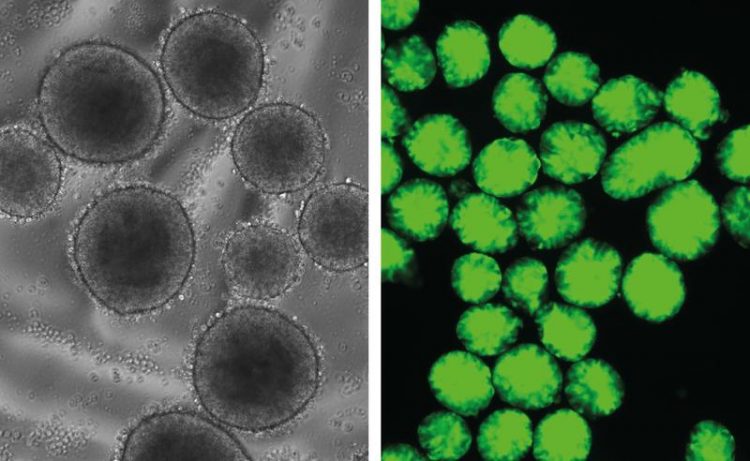Chromatin opening elements allow tetracycline inducible gene expression in stem cells

Induced transgene expression (GFP, green fluorescence) in first stages of differentiation from iPS cells. Comparison between transmitted light and fluorescence microscopy. Source.: PEI
Ever since the discovery of the reprogramming of normal (somatic) body cells in so-called induced pluripotent stem cells (iPS cells), the development of cell therapeutics from such pluripotent stem cells has gathered momentum.
While somatic cells represent specialized cells and are predetermined for one particular cell type, pluripotent stem cells can differentiate into quite a variety of different cell types. This very property is used for the development of cell therapeutics.
Not only the conversion of a normal body cell into the induced pluripotent stem cells is of scientific interest, but the road from these “formable” cells into the desired cell type (effector cell), too, represents a challenge in research.
This can be supported, among other things, by transcription factors inserted by genetic modification of the pluripotent cells. Only the activity in defined time windows will generate a benefit. Insertion of the foreign genetic information into the cells is frequently carried out using retroviral vectors.
Defective cells can thus be corrected, or the efficiency of somatic cell production from iPSC can be enhanced.
During this process, however, integrated retroviral vector genomes are often “silenced” by epigenetic mechanisms. This involves methyl groups, which are attached to certain gene sections (transgenic expression cassettes).
These methyl groups have a kind of sealing effect. The advantage of these newly inserted genes is then lost, and even the differentiation of the cells can be stopped.
How can silencing be prevented without affecting inducibility? Professor Ute Modlich's research group “Gene Modification in Stem Cells”, Division Veterinary Medicine of the PEI and colleagues of Division Medical Biotechnology developed inducible vectors which keep the gene modified site open by means of ubiquitous chromatin opening elements.
For this purpose, they inserted various fragments of the human HNRPA2B1-CBX3 UCOE into inducible retroviral vectors. The vectors can be induced using a promoter which is in turn activated by the antibiotic tetracycline. This one vector contains all that is necessary. Thanks to this property, it is also referred to as “all-in-one vector”.
In a next step, the researchers tested the functionality of the vectors in various cell lines and in iPSCs of mice and men. They were able to prove that inserting the UCOE would not impair the regulation of the vectors. Switching them on – which is important for good therapeutic efficacy – and off was possible without any problems.
This, in turn, is important to avoid effects of interference. Some of the tested vectors preserved their activity in iPSC of mice and humans, both in the pluripotency, and in the differentiation stage.
From the researchers’ point of view, these new vectors allow genetic modification of iPS cells with safe regulation of transgene expression. In a next step, the researchers swill use the vectors to efficiently produce blood cells from iPS cells.
Cullmann K, Blokland KEC, Sebe S, Schenk F, Ivics Z, Heinz N, Modlich U (2018): Sustained and regulated gene expression by Tet-inducible “All-In-One” retroviral vectors containing the HNRPA2B1-CBX3 UCOE.
Biomaterials Nov 24 [Epub ahead of print].
DOI: doi.org/10.1016/j.biomaterials.2018.11.006
https://www.sciencedirect.com/science/article/pii/S014296121830783X?via%3Dihub – Abstract
https://www.pei.de/EN/information/journalists-press/press-releases/2018/25-chrom… – this press release on the PEI Website
Media Contact
All latest news from the category: Life Sciences and Chemistry
Articles and reports from the Life Sciences and chemistry area deal with applied and basic research into modern biology, chemistry and human medicine.
Valuable information can be found on a range of life sciences fields including bacteriology, biochemistry, bionics, bioinformatics, biophysics, biotechnology, genetics, geobotany, human biology, marine biology, microbiology, molecular biology, cellular biology, zoology, bioinorganic chemistry, microchemistry and environmental chemistry.
Newest articles

NASA: Mystery of life’s handedness deepens
The mystery of why life uses molecules with specific orientations has deepened with a NASA-funded discovery that RNA — a key molecule thought to have potentially held the instructions for…

What are the effects of historic lithium mining on water quality?
Study reveals low levels of common contaminants but high levels of other elements in waters associated with an abandoned lithium mine. Lithium ore and mining waste from a historic lithium…

Quantum-inspired design boosts efficiency of heat-to-electricity conversion
Rice engineers take unconventional route to improving thermophotovoltaic systems. Researchers at Rice University have found a new way to improve a key element of thermophotovoltaic (TPV) systems, which convert heat…



